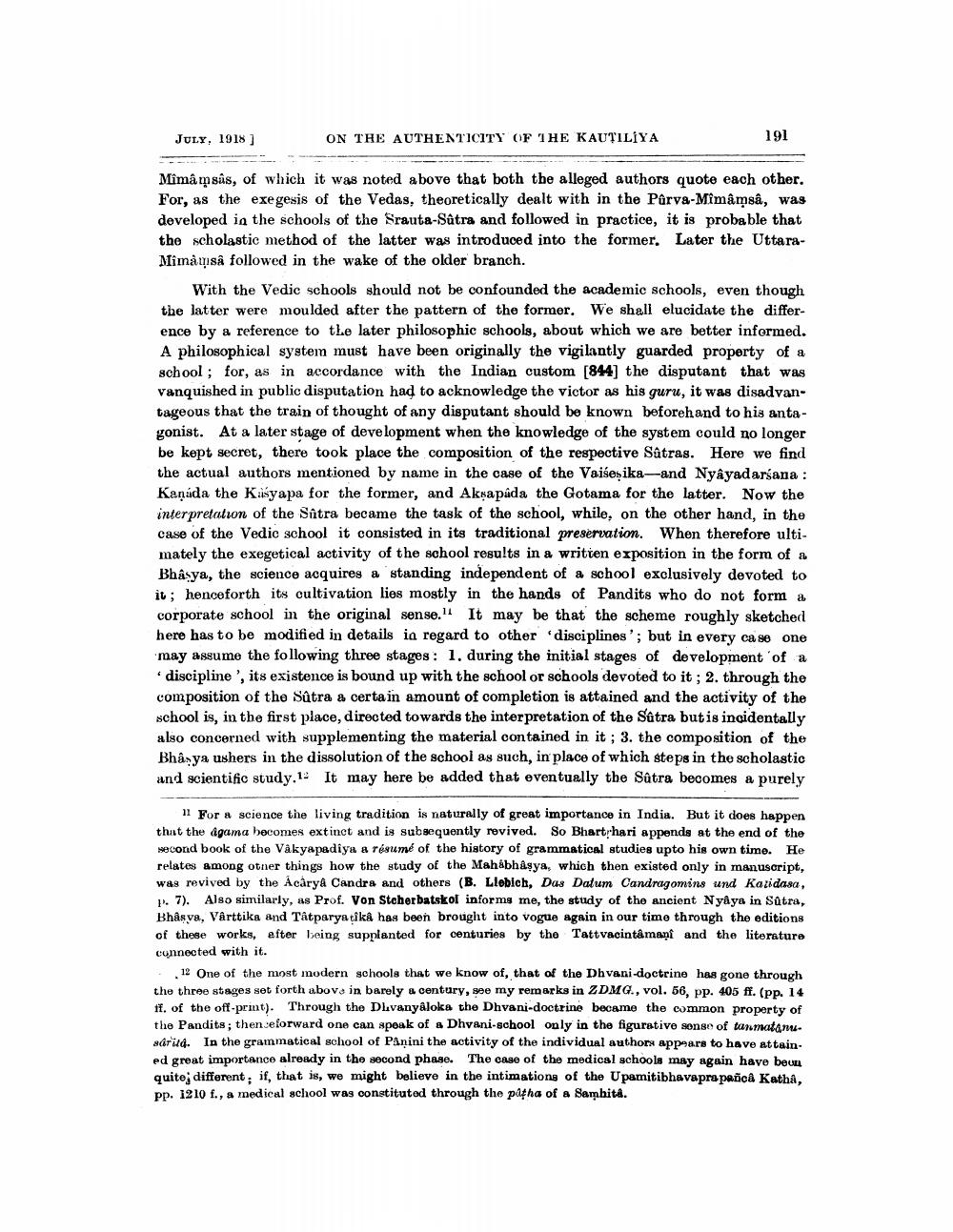________________
JULY, 1918 ]
ON THE AUTHENTICITY OF THE KAUTILİYA
191
Mîmâm sâs, of which it was noted above that both the alleged authors quote each other. For, as the exegesis of the Vedas, theoretically dealt with in the Pârva-Mimâmsa, was developed in the schools of the Srauta-Sûtra and followed in practice, it is probable that the scholastic method of the latter was introduced into the former. Later the UttaraMimmiså followed in the wake of the older branch.
With the Vedic schools should not be confounded the academic schools, even though the latter were moulded after the pattern of the former. We shall elucidate the difference by a reference to the later philosophic schools, about which we are better informed. A philosophical system must have been originally the vigilantly guarded property of a school; for, as in accordance with the Indian custom [844] the disputant that was Vanquished in public disputation had to acknowledge the victor as his guru, it was disadvantageous that the train of thought of any disputant should be known beforehand to his antagonist. At a later stage of development when the knowledge of the system could no longer be kept secret, there took place the composition of the respective Sätras. Here we find the actual authors mentioned by name in the case of the Vaiseșika-and Nyâyadarsana: Kanada the Kasyapa for the former, and Aksapáda the Gotama for the latter. Now the interpretation of the Satra became the task of the school, while, on the other hand, in the case of the Vedic school it consisted in its traditional preservation. When therefore ultimately the exegetical activity of the school results in a written exposition in the form of a Bhâsya, the science acquires a standing independent of a school exclusively devoted to it; henceforth its cultivation lies mostly in the hands of Pandits who do not form a corporate school in the original sense. It may be that the scheme roughly sketched here has to be modified in details ia regard to other disciplines'; but in every case one may assume the following three stages: 1. during the initial stages of development of a • discipline', its existence is bound up with the school or schools devoted to it; 2. through the composition of the Sûtra & certain amount of completion is attained and the activity of the school is, in the first place, directed towards the interpretation of the Satra but is incidentally also concerned with supplementing the material contained in it; 3. the composition of the Bhâsya ushers in the dissolution of the school as such, in place of which steps in the scholastic and scientific study. 12 It may here be added that eventually the Sûtra becomes a purely
11 For a science the living tradition is naturally of great importance in India. But it does happen that the agama becomes extinct and is subsequently revived. So Bhartrhari appends at the end of the wecond book of the Vakyapadiya & résume of the history of grammatical studies upto his own time. He relates among other things how the study of the Mahabhâsya, which then existed only in manuscript, was revived by the Acarya Candrs and others (B. Lieblch, Das Datum Candragomins und Karidasa, p. 7). Also similarly, as Prof. Von Steherbatskol informs me, the study of the ancient Nyâya in Satra, Bhåsva, Vårttika And Tâtparyatika has been brought into vogue again in our time through the editions of these works, efter being supplanted for centuries by the Tattvacintamani and the literature connected with it.
12 One of the most modern schools that we know of, that of the Dhvani-doctrine has gone through the three stages set forth abova in barely a century, see my remarks in ZDMG., vol. 56, PP. 405 ff. (pp. 14 ff. of the off-print). Through the Dlvanyaloka the Dhvani-doctrine became the common property of the Pandits; thenceforward one can speak of a Dhyani-school only in the figurative song of tanmatansaritd. In the grammatical school of Panini the activity of the individual authors appears to have attained great importance already in the second phase. The case of the medical schools may again have been quite different, if, that is, we might believe in the intimations of the Upamitibhavapra panca Katha, pp. 1210 f., a medical school was constituted through the patha of a Sambiti.




